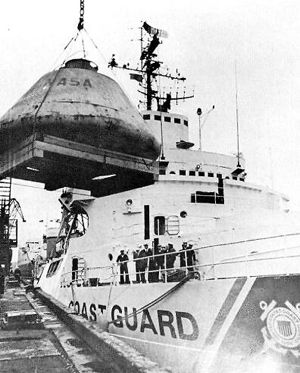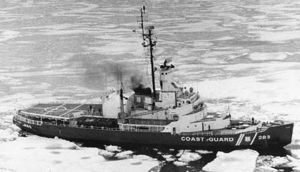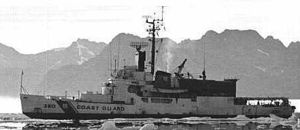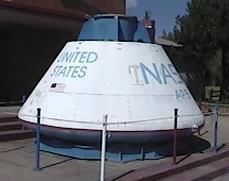
Home - Search - Browse - Alphabetic Index: 0- 1- 2- 3- 4- 5- 6- 7- 8- 9
A- B- C- D- E- F- G- H- I- J- K- L- M- N- O- P- Q- R- S- T- U- V- W- X- Y- Z
Apollo: Soviets Recovered an Apollo Capsule!
In 2002 this web site broke the story that the Soviet Union had recovered an Apollo capsule in 1969 and returned it to the Americans a year later in the extraordinary Cold War visit to Murmansk by the American Coast Guard icebreaker Southwind. Recently Michael Stronski, a Southwind crew member, has provided additional extraordinary photographs of the event.
The icebreaker Southwind was commissioned as a US Navy vessel on 15 July 1944 but was transferred to the Soviet Union on 25 March 1945 and named Kapitan Belousov. It was returned to the US Navy five years later and renamed Atka. After years of Arctic and Antarctic service it was handed over to the US Coast Guard on 31 October 1966 and reverted to its original name of Southwind. After a refitting its first cruise was to the Antarctic, where it ripped its bottom out in Palmer Bay and limped back to the United States at 10 knots.
In early 1970, UK-based naval units were training in recovery of an Apollo boilerplate capsule (BP-1227) as part of their assigned mission of rescuing Apollo spacecraft in the case of an emergency abort or return to earth. The capsule disappeared at sea. The circumstances of the loss of the capsule are still not clear. It is not known whether a Soviet 'fishing vessel' nearby was in fact a spy trawler and if the capsule was taken as part of an intelligence operation. This photograph shows the capsule in 2002, when it was serving as a time capsule not to be opened until 2076, at Grand Rapids, Michigan, USA.
In June - November 1970 the Southwind was sent on an extended Arctic cruise, conducting oceanographic surveys in the Barents and Kara Seas and resupplying US polar bases. Following a visit to Greenland, the Southwind reached 83 deg 01 min N on 15 August 1970. Only 419 miles from the pole, this was the northernmost point reached by a US icebreaker to that date.
The breaker was finally stopped by solid ice at least 10 to 15 feet thick. Due to global warming, by 2007 the ice thickness was half that at this latitude and a waterway one mile wide opened up. This was the first time in millions of years that this had happened. Michael Stronski notes: "I take it our crew were one of the very last to see the pole as it has been for millions of years".
A buoy was marked to commemorate the event….and dropped into the Arctic Ocean. Since it was payday, they were told this made them the 'highest paid crew in the Coast Guard'.
In the far Arctic the Southwind became locked in the ice. A polar bear, named Rodney by the crew, ambled up to the icebreaker. They fed him pizza, Cornish game hens, and finally lasagna. Throughout the cruise, every time they passed by any of then-numerous polar bears they would feed them something from the ship's mess. But Rodney was the only one to hang around for an extended time.
After getting clear of the ice and heading south, the crew was surprised to find itself being trailed by a Soviet icebreaker, which they dubbed 'Vladimir'. The ship followed them everywhere, but always keeping a proper distance, and hoisting proper signals when the Southwind came to a stop.
Southwind then stopped in Iceland and went on to make a visit to Murmansk. This so-called "courtesy call" was the first visit to the Soviet port of a US military vessel since World War II. This photograph shows Deputy Commander of the Soviet Northern Fleet, Rear Admiral Garkusha and his staff boarding the Southwind from the pilot boat at the entrance to Murmansk sound. Stronski remembers, "All cameras were suppose to be below deck and all port holes closed. Like a nut I got this picture off from the hanger bay. Was called to the captains office on this one…"
The Southwind was opened to the public, and over 700 Soviet citizens toured the vessel over the next few days, including Soviet staff officers. The crew was given shore leave on 6 September 1970 and had the unique Cold War experience of buying Soviet rubles and visiting the tourist sites of Murmansk, such as the shops and theaters, the stadium, and the busy streets.
While in Murmansk the crew was surprised to be presented with an American Apollo capsule, which the Soviets said had been recovered by one of their fishing vessels in the Bay of Biscay. It was BP-1227 - the capsule that had gone missing a year earlier. The handover was made with considerable ceremony and covered by Hungarian press representatives. The capsule was loaded onto the ship at the forward gun mount. Lashed to the deck, it accompanied the Southwind after its departure from Murmansk and later tour of the Kara Sea.
While in the Kara Sea, there was an incident where the ship was bumped in the early morning hours by 'Vladimir', the Soviet icebreaker that still shadowed them. Stronski remembers, "I was on the bow at that moment and general quarters was sounded. The next day our choppers flew over their ship and drop some bags of garbage on their bridge … pay back time.. " The crew ignored the provocation and continued on their planned cruise.
Following visits to Tromso and Oslo, Norway and Copenhagen, Denmark, the Southwind docked at Portsmouth, England, where the capsule may have been unloaded and turned over to the Royal Navy. It then proceeded to Nova Scotia before finally returning to its home port in Maryland.
Following the completion of the Apollo program, BP-1227 was returned to NASA and then handed over to the National Air and Space Museum. It was finally loaned for one hundred years to the city of Grand Rapids, Michigan, to serve as a US bicentennial time capsule. It is currently on display in Grand Rapids, and not to be opened until 2076.
The circumstances of the loss of the capsule are still not clear. It is not known whether the Soviet 'fishing vessel' was in fact a spy trawler and if the capsule was taken as part of an intelligence operation. If so, little of value could be obtained from the boilerplate. While the parachute compartments and recovery aids at the top of the boilerplate were probably representative of flight hardware, the rest of the capsule was built of sheet metal with a fiberglass representation of the heat shield. However US intelligence agencies had made Herculean attempts to make detailed examination of similar mock-ups or stripped versions of Soviet spacecraft so this possibility cannot be dismissed.
The story remained obscure and unknown for 32 years until a Hungarian space archivist came across a picture of the event in his archives...
 | BP-1227 Loaded Apollo BP-1227 is lifted from the pier at Murmansk onto the USCG Southwind, September 8, 1970. From the ship's cruise book. Credit: Mike Malone |
 | BP-1227 Today BP-1227 Today, a time capsule not to be opened until 2076, at Grand Rapids, Michigan, USA. Credit: © Mark Wade |
 | Wind Class Breaker Soviets Recovered an Apollo Capsule! Credit: US Coast Guard |
 | BP-1227 Plaque BP-1227 nameplate, which mentions its recovery by the Soviet Union and handover to the United States. Credit: © Mark Wade |
 | Southwind The USCG Icebreaker that received an Apollo capsule from the Soviet Union at Murmansk, 1971. Credit: US Coast Guard |
Back to top of page
Home - Search - Browse - Alphabetic Index: 0- 1- 2- 3- 4- 5- 6- 7- 8- 9
A- B- C- D- E- F- G- H- I- J- K- L- M- N- O- P- Q- R- S- T- U- V- W- X- Y- Z
© 1997-2019 Mark Wade - Contact
© / Conditions for Use


